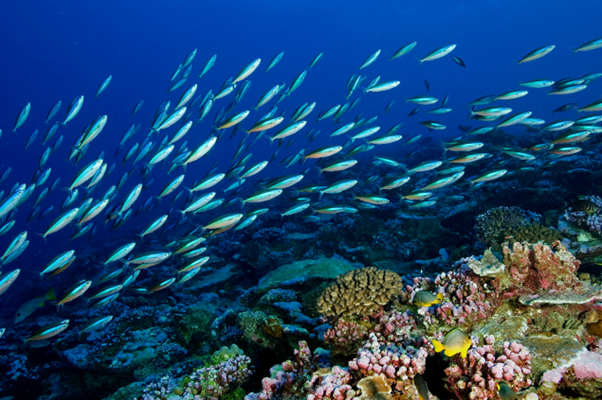President Trump has said he will allow commercial fishing in one of the world’s largest MPAs, introducing industrial operations for the first time in more than a decade to a vast area of the Pacific dotted with coral atolls and populated by endangered sea turtles and whales. As reported in the New York Times, Mr. Trump issued an executive order opening up the Pacific Islands Heritage Marine National Monument, which lies some 750 miles west of Hawaii and is one of the world’s largest MPAs.
Photo: Palmyra Atoll, part of the Pacific Remote Islands Marine National Monument
President George W. Bush established the monument, formerly known as the Pacific Remote Islands Marine National Monument, in 2009 and President Barack Obama expanded it in 2014 to its current area of nearly 500,000 square miles. The Order allows U.S.-flagged vessels to fish commercially within 50 to 200 nautical miles of the National Monument’s boundaries.
An accompanying fact sheet from The White House said that ‘as a result of the prohibitions on commercial fishing, American fishing fleets have lost access to nearly half of the United States’ Exclusive Economic Zone in the Pacific Islands. This has driven American fishermen to fish further offshore in international waters to compete against poorly regulated and highly subsidized foreign fleets, most notably from China.’
‘The world’s dominant seafood leader’
A second executive order directed the Commerce Department to loosen regulations that “overly burden America’s commercial fishing, aquaculture, and fish processing industries.” It also asks the Interior Department to conduct a review of all marine monuments and issue recommendations about any that should be opened to commercial fishing.
“The United States should be the world’s dominant seafood leader,” Mr. Trump wrote. “The Order strengthens the U.S. fishing industry by reducing regulatory burdens, combating unfair foreign trade practices, and enhancing domestic seafood production and exports,” a White House statement said.
The United States, despite controlling over four million square miles of prime fishing grounds, imports nearly 90% of its seafood, leading to a trade deficit exceeding $20 billion, the White House said.
Photo: Blue streak fusiliers, Pterocaesio tile. Palmyra Atoll, USA.
‘A gift to industrial fishing fleets’
The marine monument, a chain of islands and atolls amid more than 160 seamounts, has been described as “the most widespread collection of marine and terrestrial-life protected areas on the planet under a single country’s jurisdiction”. They protect many endemic species including corals, fish, shellfish, marine mammals, seabirds, and vegetation not found elsewhere. Environmentalists said opening the area to commercial fishing would pose a serious threat to the area’s fragile ecosystems.
“This is a gift to industrial fishing fleets and a slap in the face to science and the generations of Pacific Islanders who have long called for greater protection of these sacred waters,” said Maxx Phillips, director for Hawaii and Pacific Islands at the Center for Biological Diversity, an environmental nonprofit organization.
Angelo Villagomez, a senior fellow at the Center for American Progress, said opening marine monuments to industrial fishing “sets a dangerous precedent that our public lands and waters are for sale to the highest bidder.”
Solomon Kahoʻohalahala, a native Hawaiian elder, said in Mongabay, “Opening this sacred place for exploitation is short-sighted and does not consider current or future generations of Pacific People who rely on a healthy ocean, and know this special ocean space as our ancestral home.”

